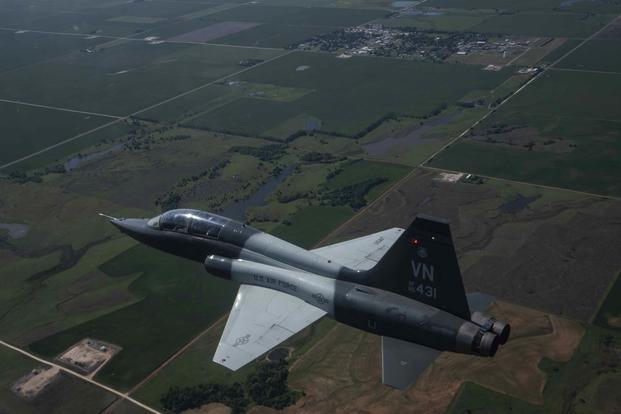The Air Force has identified one pilot involved in Friday's T-38 Talon crash in Montgomery, Alabama.
Killed in the crash was Scot Ames Jr., an instructor pilot with the 50th Flying Training Squadron at Columbus Air Force Base, Mississippi, the base said in a release Sunday. Ames, a Pekin, Indiana native, was 24, officials from the 14th Flying Training Wing said in the release.
The student pilot, also killed in the crash, was a member of the Japanese Air Self Defense Force training in the U.S. The pilot's name was withheld pending Japanese government approval, the release said.
Read Next: In a Navy with Lots of Traditions, a Small, Very Personal One Continues
The aircraft, belonging to the14th Flying Training Wing at Columbus, went down around 5:30 p.m. near Alabama's Dannelly Field.
The pilots were on a routine, "cross country" training mission, which involves pilots flying to another airport or airfield from the base, Col. Seth Graham, commander of the 14th, said during a news conference Saturday. Graham said flight operations have been temporarily suspended, and officials are evaluating when they can resume.
Graham did not provide further details into the cause of the crash, citing an ongoing investigation.
"Our Air Force investigators are performing their time-tested process used to investigate mishaps like this, and they will ensure the integrity of the investigation," Graham said in Sunday's release. "The Air Force is committed to providing the safest working environment for its people; the safety of our people and the surrounding communities is our foremost concern."
The crash comes a day after another incident involving the T-38.
On Thursday, a trainer jet assigned to the 9th Reconnaissance Wing at Beale Air Force Base, California, was forced to execute a "gear-up landing" at Mather Airport, California. The two pilots aboard sustained no injuries during the accident, according to a Beale spokesperson.
There have been previous incidents involving T-38s from the Mississippi base.
In May 2018, two pilots ejected from their T-38 near Columbus; the plane crashed in a remote part of northeast Mississippi, officials said at the time. In August the same year, the base halted flight operations for 24 hours after a T-38 ejection seat inadvertently fired while the plane was undergoing inspection. Three maintainers were injured in the incident, according to Air Force Times.
The twin-engine, high-altitude T-38 is used to train pilots to fly in fighter and attack aircraft such as the F-15 Eagle, F-16 Fighting Falcon, A-10 Thunderbolt and F-22 Raptor, as well as the B-1B Lancer.
Pilots have noted feeling strain when conducting basic maneuvers in the T-38 because its shape -- most notably its stubby wings -- gives it unforgiving tendencies. The aircraft performs best at high speeds and is much more challenging to fly when pilots are working on slow-speed fundamental skills, a former T-38 instructor told Military.com last year.
The service has plans to replace the Northrop Grumman Corp.-made, two-seater T-38, some of which date back to the mid-1960s.
In September 2018, the service awarded Boeing Co. a $9.2 billion contract to build a replacement aircraft, with a working name of T-X. In 2019, the Air Force rebranded the T-X as the T-7A Redhawk, named in honor of the Tuskegee Airmen.
The first T-7A is expected to be delivered in 2023, along with new flight training simulators.
-- Oriana Pawlyk can be reached at oriana.pawlyk@military.com. Follow her on Twitter at @Oriana0214.
Related: After Fatal Jet Crash, the Pilots Got Blamed. Then the Air Force Banned the Flight Maneuver













